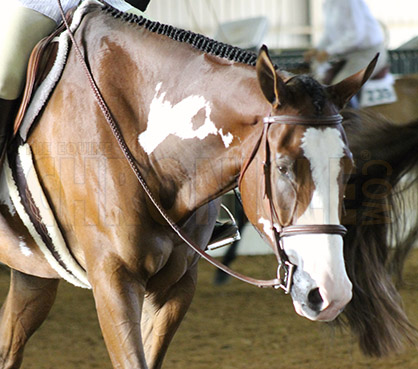Do You Know How to Properly Fit Your Horse’s Bridle?
 Michigan State Extension by: Taylor Fabus
Michigan State Extension by: Taylor Fabus
A bridle is essentially three parts: head piece or headstall, bit, and reins. Bridles may also contain cavessons (nosebands), browbands, ear loops and chin straps. A properly fitted bridle will allow the horse and rider to communicate more effectively while minimizing risk of injury to horse or rider.
Before riding, the rider should always check the entire bridle for any abnormal wear or weakness. Reins should be well attached to the bit by rivets or screws or secured by leather ties. The head piece of the bridle should be properly attached to the bit. Leather should be regularly conditioned to prevent breakage due to drying and cracking. Cleaning your leather tack after riding by simply wiping down with a damp cloth will extend the life of the leather. If you’d like to learn more about extending the life of your tack, check out this Michigan State University Extension article, “Top five tips to maximizing the life of your horse tack and equipment.”
The length of the cheekpieces determines where the bit will rest in the mouth. This adjustment may be made on one or both sides of the bridle. Adjust the cheekpieces so the bit makes one or two small wrinkles in the corner of the horse’s mouth. If the cheekpieces are too long, the bit will be too low in the mouth. This puts too much pressure on the tongue and may bump against the front teeth. It also permits the horse to put its tongue over the bit easily. If the cheekpieces are too short, the bit will be too high in the horse’s mouth, resulting in too much pressure at the poll and pinching at the corners of the mouth.
A noseband or cavesson must also be adjusted properly. Adjust the noseband to lie about 2 inches below the point of the horse’s cheekbones. Adjust the noseband so it has two fingers’ width of slack between the horse’s nose and the noseband.
With a curb bit, one of the most critical adjustments on the bridle is the curb strap or chain. The bit will not work properly unless this adjustment is correct. Fasten the curb strap so the bit will rotate about 45 degrees in the horse’s mouth before the curb begins to apply pressure.
It’s also a good idea to have a strap at the throat latch. On multiple occasions, I have seen horses shake or rub the bridle off their head without one. These straps are common on an English style bridle (where you can find a Kimberwicke bit), but less common on western style bridles. When properly adjusted, the throatlatch should accommodate at least three fingers between the throat and the strap.
Another thing to note, with trends changing rapidly, I have noticed large buckles or conchos becoming popular. Be sure this buckle or concho is clear of the horse’s eye. It could potentially interfere with their already limited line of vision or potentially injure the eye if they come in contact.
If you’d like to learn more about selecting the appropriate bit for your horse, I encourage you to visit eXtension’s Horses webpage and see their article, “Bit Selection for Riding and Training Horses.”
This article was published by Michigan State University Extension. For more information, visit http://www.msue.msu.edu. To have a digest of information delivered straight to your email inbox, visit http://bit.ly/MSUENews. To contact an expert in your area, visit http://expert.msue.msu.edu, or call 888-MSUE4MI (888-678-3464).










